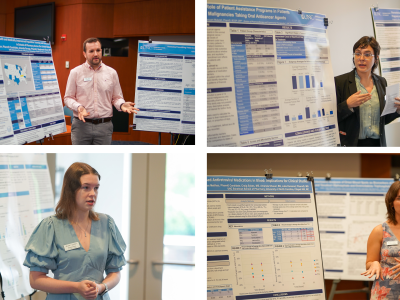February 12, 2021

The National Institute of Environmental Health Sciences (NIEHS) recently announced UNC Eshelman School of Pharmacy faculty paper “Computational modeling identifies drug candidates for SARS-CoV-2” as one of the organization’s 2020 Papers of the Year.
The publication, with Alex Tropsha, Ph.D. and Eugene Muratov, Ph.D., both in the UNC Eshelman School of Pharmacy’s Division of Chemical Biology and Medicinal Chemistry, as senior authors along with co-authors at the NIEHS and members of the Tropsha lab, was selected as one of 27 from nearly 3,500 publications by NIEHS researchers and grantees in 2020, according to the organization’s website.
“It is a great honor and pleasure to land on this list. We are extremely honored that the study that involved UNC’s undergrad and grad students and postdocs gained this recognition,” Tropsha said.
“Computational modeling identifies drug candidates for SARS-CoV-2” outlines how the scientists and their collaborators used computational modeling to examine databases to identify existing drugs that showed antiviral activity in confirmatory biological assays and that could be repurposed to fight SARS-CoV-2, the virus that causes COVID-19.
They targeted an essential step in the formation of infectious viral particles, the breakdown of precursor viral proteins by viral proteases. A class of antiviral drugs called protease inhibitors block the activity of viral proteases. The main protease (Mpro) of SARS-CoV-2 is a proposed target for COVID-19 drugs. The structure and activity of Mpro is highly conserved across the coronavirus family.
In this study, previous data on drug interactions with SARS-CoV Mpro were used to develop quantitative structure-activity relationship models, which the team used to virtually screen all drugs in the DrugBank database. They identified 42 drugs that were predicted to inhibit SARS-CoV-2 Mpro. Of these computational hits, Sufugolix, Cenicriviroc, and Proglumetacin were tested experimentally in cellular assays at the National Center for Advancing Translational Sciences (NCATS) at the NIH, and their antiviral activity was confirmed.
“Our results support the value of modeling for guiding the experimental investigations of putative anti-COVID-19 drug candidates. Recently, similar models combined with other computational tools were also successfully used for discovery of synergistic drug combinations against SARS-CoV-2,” Muratov said.
Additional authors on the publication include: Vinicius M. Alves, Tesia Bobrowski, Cleber C. Melo‐Filho, Daniel Korn of UNC and Scott Auerbach, and Charles Schmitt of NIEHS.
Latest News

Dean Angela Kashuba receives Carolina Alumni Faculty Service Award

RASP poster presentations capture student research


